Cast iron cookware is awesome! The cookware is easy to care for, and cooks food at an even heat. Learn how to season your pans to get that wonderful non-stick coating!
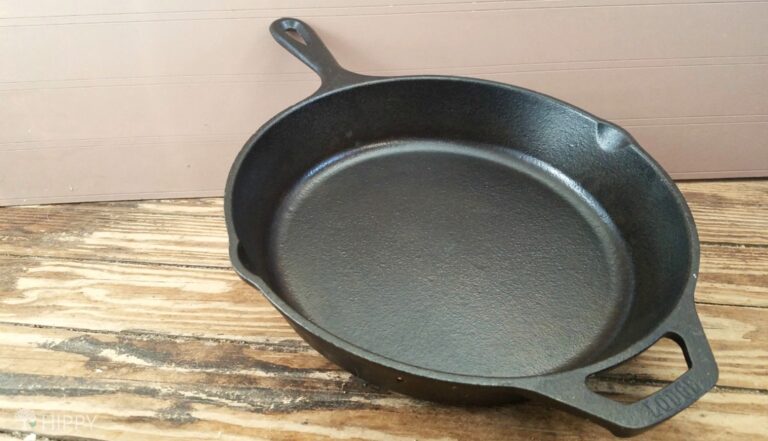
Cast iron is amazing. No matter what size pan or pot, you can go from meats to desserts with equal ease. Once your pan is well seasoned, there’s almost nothing you can’t do with it. It will be non-stick and food will amazingly come right off, with very little effort.
I have about half a dozen pans and let me tell you – they’re an indispensable part of my kitchen!
However, like with anything new, you need to know how to season cast iron properly in order to make the most of it.
There are a lot of different ways to season your cast iron. The idea is to use a saturated fat that will cool onto the cast iron and stay.
In this blog post, I’ll walk you through the steps on how to season cast iron so that you can start cooking like a pro!
Table of Contents
What Oils Can I Use for Seasoning Cast Iron?
Vegetable oil, such as corn or soybean, can be used, if you really want, but it’s not preferable due to the consistency (and the idea that it’s not a healthy fat).
A saturated fat will help seal the pores of the cast iron pan, and will solidify enough that it will not drip off.
Saturated fats are also high heat resistant and will not break down when the pan is heating for food use. The fatty acids will help you season your pan with ease.
Some fats you can use to season your cast iron skillets with:
- Rendered tallow
- Coconut oil
- Grapeseed oil
- Canola oil
- Palm oil
- Flax oil
- Melted shortening
What Does it Mean to “Season” A Cast Iron Pan?
When it comes to cooking, there are many different methods and techniques that can be used to create a delicious dish.
One of the most important methods is known as seasoning. Seasoning involves adding a layer of fat or oil to a pan or other cookware, which helps to create a non-stick surface and prevents the food from sticking to the cooker.
While this method is commonly used with non-stick cookware, it can also be used with cast iron pans.
When seasoning a cast iron pan, it is important to use a high-quality oil or fat that has a high smoke point. This will help to create a durable non-stick surface that can withstand high temperatures.
In addition, it is important to avoid using soap when cleaning a seasoned pan, as this can break down the seasoning and cause the food to stick.
By following these simple guidelines, you can ensure that your cast iron pan will provide years of trouble-free cooking.
To Season a Cast Iron Pan (Or to Re-season It) With the Oven Method
Here are a few tips to help you season your cast iron pan with the most popular method of doing so – the oven method.
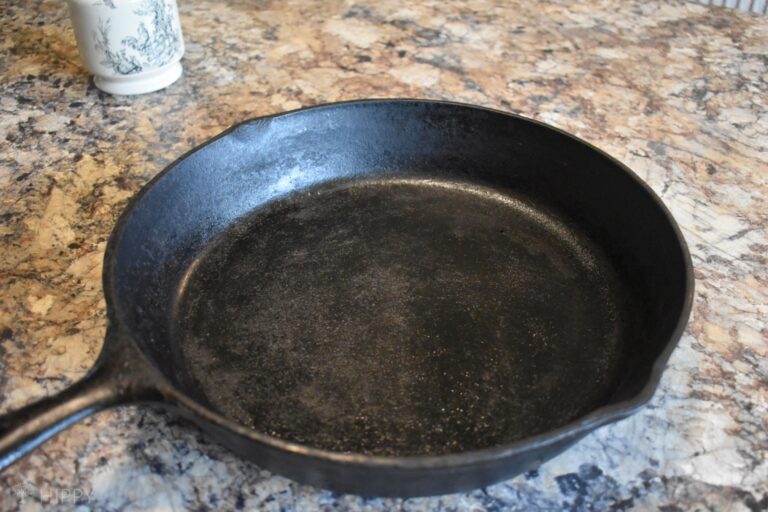
Step 1. Wash and Dry the Pan Thoroughly
First remove as much of the old food and oil residue as possible. You can use copper scouring pad to remove gunk and even rust.
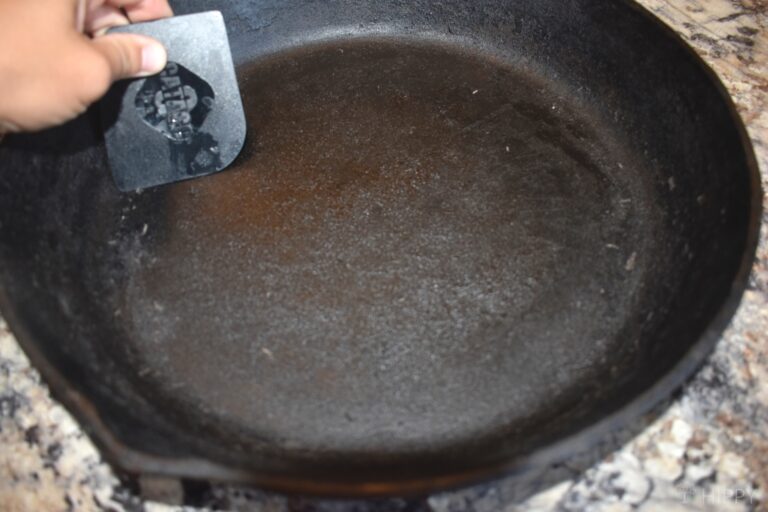
Some people will spray their pans down with oven cleaner and put in a plastic garbage bag overnight to help facilitate this. I personally just scrub them.
Step 2. Put in Bottom Rack of Your Oven and Add Oil
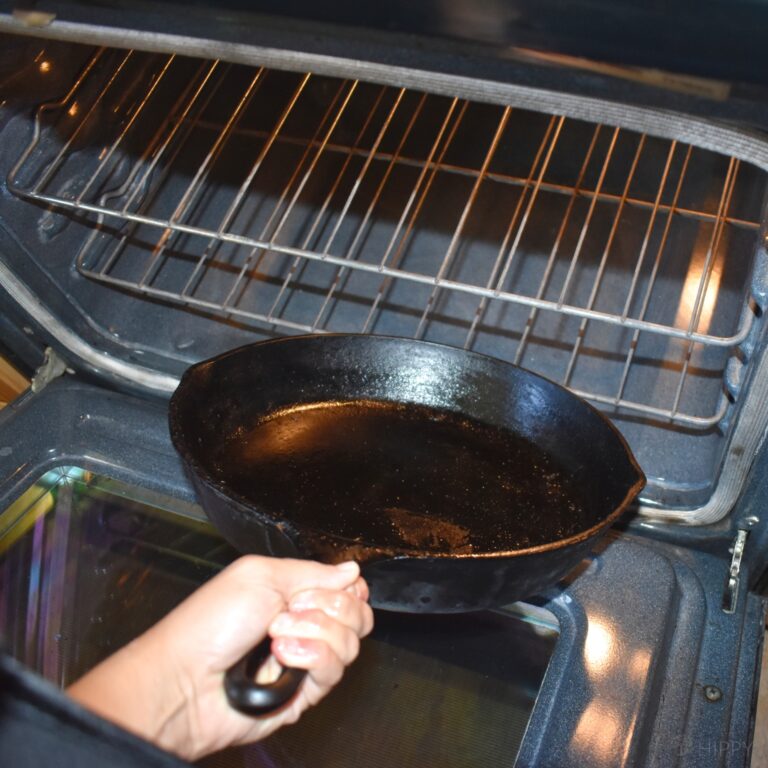
Place the cast iron pan in a 200 degree F (93 Celsius) oven to warm them up and open the pores.
Squirt about a tablespoon of flaxseed oil on the warm pan.
Tilt the pan around to allow the oil to run all over.
Using a cloth rag, gently wipe the oil to spread it evenly.
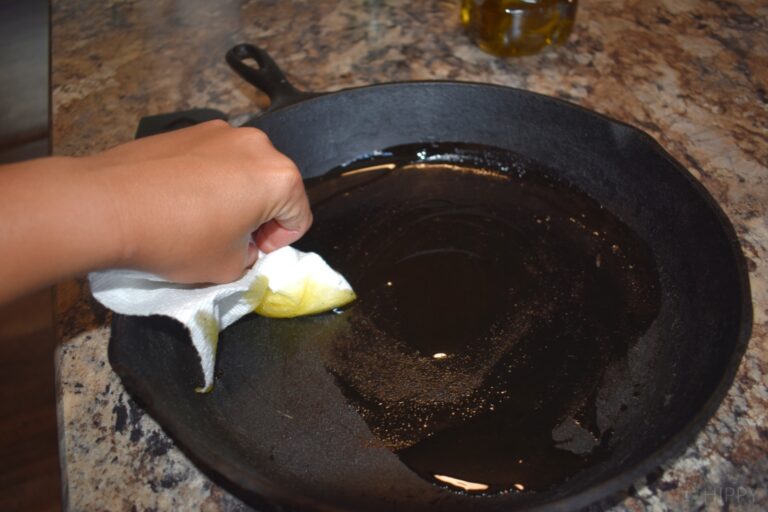
Step 3. Bake the Pan
Bake the pans, right side up, in a 500 degrees F (260 Celsius) oven for 30 minutes.
After 30 minutes, turn the oven to 250 degrees F (120 Celsius)).
CAREFULLY add a bit more flax oil to the hot pan, then allow it to spread around the cast iron pan by itself.
Return the pan to the oven.
Continue to bake at the lower temp for an additional 30 minutes.
Turn off the oven, leave the pan in the oven and allow it to fully cool. This gives it an awesome non-stick coating that will last a long time, with proper care. Repeat as needed.
You may want to season the pan multiple times. Seasoning involves coating the pan with oil or fat and then heating it until the fat polymerizes.
This creates a non-stick surface that is both durable and easy to clean. It’s important to season a new pan several times because this helps to build up the non-stick surface.
Seasoning also helps to prevent rusting and makes the pan more resistant to damage. In short, multiple rounds of seasoning are essential for getting the most out of your cast iron cookware.
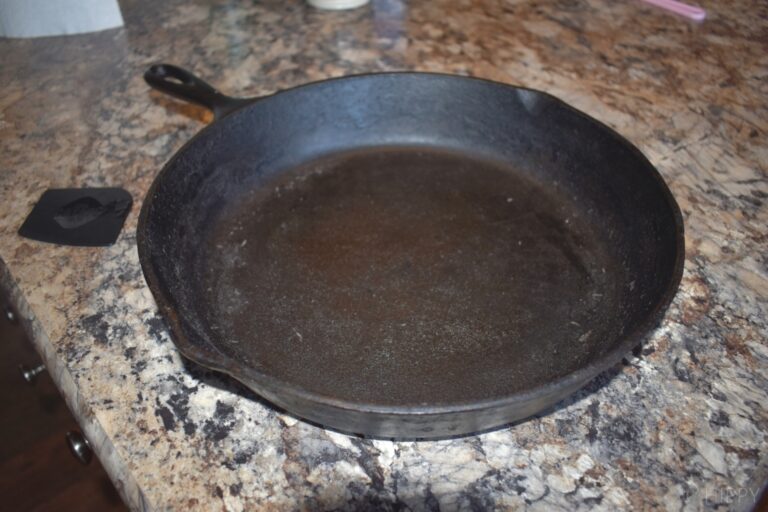
Do I Need to Season a Pre-Seasoned Cast Iron Skillet?
If you’re like most people, the idea of seasoning a cast iron skillet probably seems a bit daunting. After all, the process involves repeatedly coating the pan with oil and then baking it in the oven.
While it’s a good idea to always season your older cast iron pans, you may be wondering whether you have to season if you purchased a pre-seasoned pan.
The short answer is no, you don’t. But you need to be fragile with it – I’ll give you some of my top tips for how to “baby” your new pan below.
In any event, it’s actually quite easy to season a cast-iron skillet, and it’s well worth the effort.
A properly seasoned pan will be more nonstick and easier to clean than one that hasn’t been seasoned. In addition, seasoning helps to prevent rust and other forms of corrosion.
That said, if you’ve recently purchased a pre-seasoned skillet, there’s no need to go through the seasoning process again if you don’t want to. The skillet is ready to use right out of the box.
Cook With Fatty Foods First and Be Generous With the Oil
If you’re using a new cast iron pan, it’s important to cook with fatty foods first and be generous with the oil. This will help to season the pan and create a nonstick surface.
After you’ve seasoned your pan, consider cooking fattier foods that you want to fry, like chicken, bacon, or eggs. This is the key trick to helping the oil residue stick around and create a desirable sheen on the pan’s surface.
Avoid Abrupt Temperature Changes
When cooking with cast iron, it’s also important to avoid abrupt temperature changes. So, if you’re going from the stovetop to the oven, make sure to preheat the oven first.
And if you’re adding cold ingredients to a hot pan, do so gradually. With a little care, your cast iron pan will provide years of trouble-free cooking.
Avoid Acidic or Long-Simmered Food
When cooking with a new cast iron pan, it’s important to avoid acidic or long-simmered foods.
Acidic foods can react with the pan, causing it to develop a patina or even rust. Avoid things like tomato sauce (or really anything with tomatoes, honestly!).
Long-simmered dishes can also cause the pan to develop a coating of seasoning, which can make it difficult to clean.
Instead, opt for recipes that call for gentle cooking methods and neutral ingredients. This will help to keep your pan in good condition and prevent any unwanted flavors from developing.
Keep the Heat Low
When using a new cast iron pan, it is important to keep the heat low. This will help to prevent the pan from warping and developing hot spots.
Cleaning Cast Iron
Cleaning your seasoned cast iron is fairly simple:
- Once you are finished cooking, wipe out the pan as quickly as possible.
- If you need to wait to clean the pan, reheat it first.
- Most of the time, a well seasoned pan will only require cloth or paper towels to wipe it clean.
- For stuck food, try a plastic scraper to help remove stuck food and lingering food particles.
- Pour about ¼ cup of kosher salt on the warm pan, then scrub around to help loosen food bits.
- Rinse completely.
- Heat the pan again.
- After every use, when the pan is clean, apply a thin layer of oil on the hot pan and let it cool. Store the pan upside down to aid in the polymerization bond and to ensure that the layers of seasoning remain (and the pan doesn’t get scratched). This will help maintain the seasoning.
Some Tips on How to Care For Cast Iron
Here are a few more tips to help you care for your cast iron pan.
Avoid Dish Soap
Don’t use soap on your pans. If you need to remove hard gunk, simply add some water and boil for 10 minutes to loosen any stuck on food.
Water is Ok, But Don’t Let it Sit
Don’t allow water to just “sit” in your pan. This can cause it to rust.
Deal With Rust Promptly
If you use a cast iron pan, chances are you’ve dealt with rust at some point. Rust can happen when the pan is stored in humid conditions or when it’s not dried properly after washing.
While it may seem like rust is the end of the line for your pan, there are actually a few ways to remove it and restore your pan to its former glory.
One way to remove rust is to scrub it with a stiff brush and soap. This will usually take care of light rusting.
For more stubborn rust, you can try using a solvent like vinegar or lemon juice.
Simply apply the solvent to the affected area and let it sit for a few minutes before scrubbing with a brush. If the rust is still proving difficult to remove, you can sand it off with fine-grit sandpaper.
Once you’ve removed the rust, be sure to dry the pan thoroughly and coat it with oil to prevent future rusting. With a little elbow grease, you can keep your cast iron pan in good condition for years to come.
Don’t Marinate
When cooking with a cast iron pan, it’s important not to marinate the food. Marinating is a process of soaking food in a seasoned liquid mixture, which can infuse the food with flavor.
However, this liquid can also cause the pan to rust. In addition, the acidity in the marinade can react with the metal of the pan, giving the food an off-flavor.
For these reasons, it’s best to avoid marinating when cooking with a cast iron pan.
Instead, season the food directly before cooking, or brush on a light coating of oil to help lock in flavor. With proper care and seasoning, a cast iron pan can last for generations.
Use Salt to Clean Instead of Abrasive Scrubbies
If you’re looking for a natural and effective way to clean your cast iron pan, salt is a great option.
Abrasive scrubbers can damage the pan and remove the seasoning, but salt is gentle enough to clean without damaging the surface.
Simply sprinkle some salt onto the pan, then use a damp cloth to scrub away any dirt or debris.
Rinse the pan with hot water, and you’re done! Salt is an inexpensive and easy way to keep your cast iron pan in tip-top shape.
Apply Oil Before Each Cooking Session
Add a thin layer of oil to the pan before each cooking session. The oil helps to create a barrier between the food and the pan, preventing sticking and making cleanup a breeze.
It also helps to add flavor to the food and gives the pan a beautiful patina over time.
Clean ASAP and Apply More Oil
After cooking, clean the pan as quickly as possible. This will help remove food bits.
Once the pan is warm, wipe a thin layer of oil, such as coconut, or flax oil on the pan again and let it cool. Wipe off excess oil, if desired.
Only use soapy water if absolutely necessary, as soap can destroy the seasoning.
Storing Cast Iron Pans
Don’t stack the pans directly on top of one another for storage, as this can scratch the seasoning. Add a paper towel, cloth, or coffee filter in between each one to protect it.
What’s your favorite cast iron piece? How do you prefer to season it? Need some recipe ideas? Get over 45 delicious recipes to use on your seasoned cast iron here!
To use your cast iron, here are some quick tips:
- Heat the pan as much as you can BEFORE adding food. This will help with the non-stick factor.
- Use the pans on as low of heat as needed to cook the food properly, but not burn the pan.
- Add a bit of butter or other fat as needed to cook the food.
- Clean your pans as quickly as possibly after use.
Common Questions
A properly seasoned cast iron pan has a smooth, black surface that is easy to clean and provides excellent non stick properties. If your pan is not properly seasoned, it will have a rough surface that is difficult to clean and will not provide good nonstick properties.
As any cook knows, a cast iron pan is a versatile and durable piece of kitchen equipment. With proper care, it can last for generations.
One of the most important aspects of caring for a cast iron pan is seasoning it.
Seasoning helps to create a nonstick surface and prevents rust. Many sources recommend seasoning a new pan before first use, and then seasoning it on a regular basis.
However, there is some debate about how often seasoning should be done. Some cooks recommend doing it once a month, while others say that once a year is sufficient.
Ultimately, the frequency of seasoning will depend on how often the pan is used. If it is used regularly, it will need to be seasoned more frequently than if it is only used occasionally.
However, no matter how often it is used, it’s important to make sure that the pan is properly seasoned in order to maintain its longevity and performance.
Final Thoughts
Seasoning cast iron is a process that will protect your cookware and improve its performance. It’s not difficult, but it is important to do it properly.
We hope our guide has helped you understand the process and given you the confidence to start seasoning your own cast iron pots and pans.
Have you seasoned your cast iron yet? If so, tell us about your experience in the comments below.
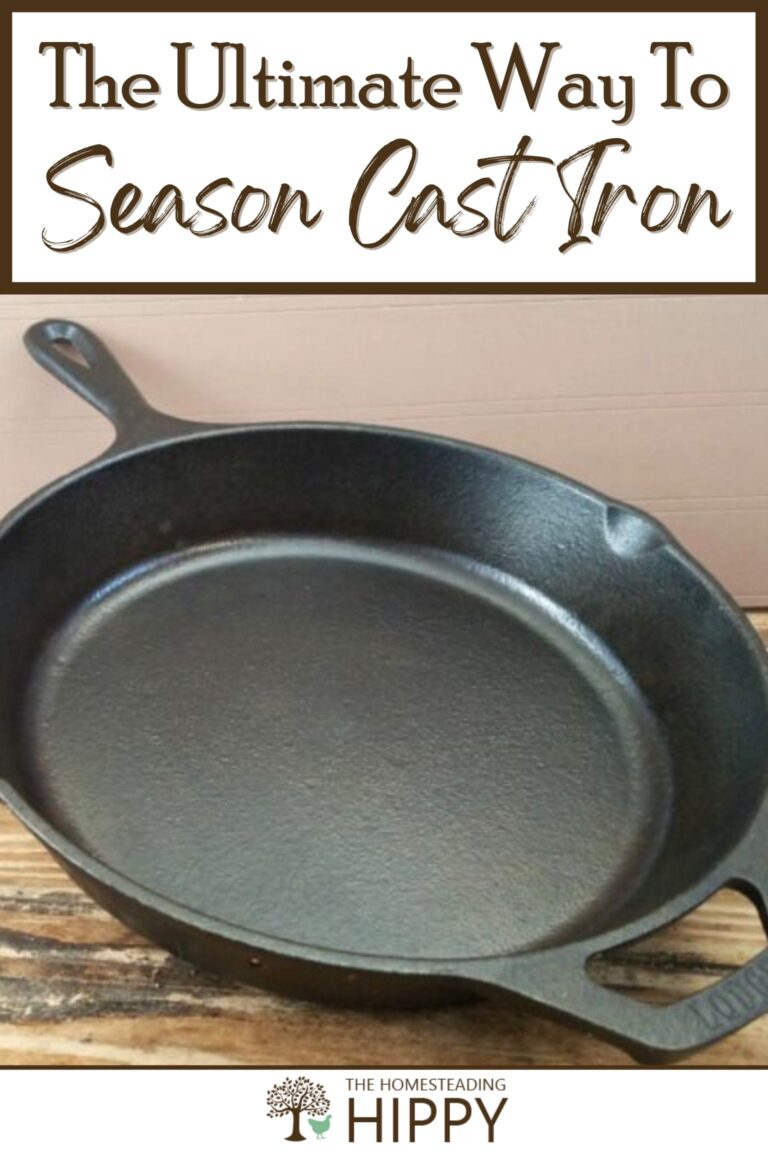

Heather’s homesteading journey started in 2006, with baby steps: first, she got a few raised beds, some chickens, and rabbits. Over the years, she amassed a wealth of homesteading knowledge, knowledge that you can find in the articles of this blog.
Learn more about Heather and the rest of the writers on this page.

I love my cast iron- I never thought of using flaxseed oil to season it.
Thanks
I’ve been meaning to season my cast iron skillets for a while now. I’ve just been so busy but I’ve really got to get it done. Thanks for the inspiration.
I would love to have some cast iron skillets. My grandmother had some nice ones and I loved them.
Love this because I just got a set of cast iron pans and will be needing this! Thanks for sharing!
I really do want to start using cast iron… especially since I have a better idea of how to take care of it. (My mother’s cast iron skillets were kind of… gross from being washed, etc.)
I have actually always wanted to know how to do this. I am thankful that I now know!
This is so awesome! Thank you for explaining how easy it is to season a cast iron pan! I just read this out loud to my hubby too lol because he was JUST complaining about our cast iron not being non-stick….we will be doing this today lol
This is the second time this week I’ve heard reference to using oven cleaner on cast iron. no, no, no, no, no. As mentioned in the post, cast iron is porous, which means the oven cleaner will absorb into the pan and leach back out when heat is applied. PLEASE don’t do that! Thank you for the post. I’m going to try flax seed oil.
Great thought, Melanie! thanks!
I use bacon grease or coconut oil. And have honestly never rescrubbed them or preheated them, just add the grease and bake at high heat. Sometimes when running the cleaning cycle.
Thanks so much for sharing this tip. I am not sure that I would have ever known this otherwise. Very helpful!
I didn’t know this. Seasoning my pans now!!! Thanks!!
I’ve never thought to use flax seed oil either! I grew up with my mother using olive oil (my father was Greek so everything was olive oil!) so that’s all I have ever known but this I may have to try. Thank you for sharing another great idea.
Be sure to let me know how you like it!!
so glad that im not alone in saving potato water and bean water. I freeze it in qt containers and use it when i make veggie broth from all my peels and pits and seeds that i have frozen. that includes stuff like apple peels and cores. vegetable broth makes a huge difference in a recipe.